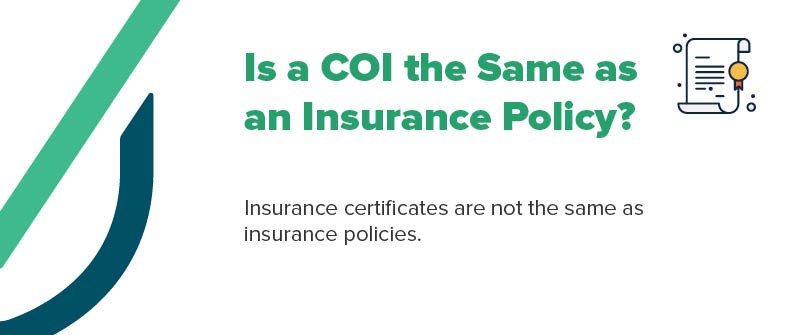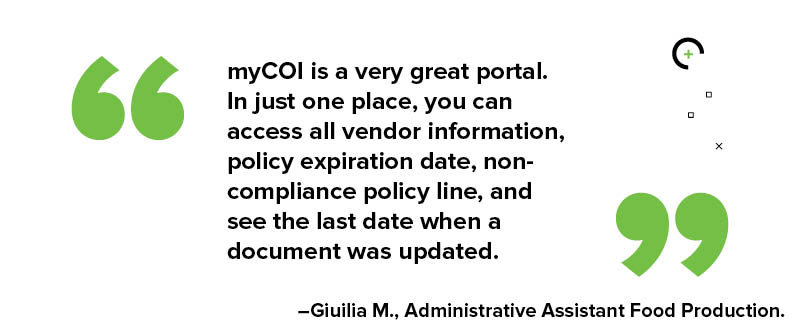We have some good news and some bad news. Let’s start with the bad: it has been a difficult year, which has created the hardest insurance market in over a decade. That means businesses and risk managers are feeling those negative effects when procuring and renewing insurance. Coverage is going down and rates are going up. You can expect higher premiums, a challenging underwriting process, increased retention, and new exclusions.
What are COIs, why do companies need them from vendors, and why would anyone need to renew them? We’ll cover a COI’s meaning and answer these questions and more in our ongoing Certificate of Insurance 101 series in this guide to COI renewal management.
What Does COI Stand For?
A COI stands for “certificate of insurance.” Also known as an insurance certificate, a COI refers to an important document that acts as proof of an insurance policy. Since they can only be produced by the insurance provider granting coverage to a policyholder, they are official legal documents and can be trusted as evidence of someone’s insurance coverage.
Understanding the Components of a COI
Before we dive deeper into the renewal management process, it’s essential to understand what makes up a Certificate of Insurance (COI). Knowing the components of a COI can help you better assess the coverage of your vendors and ensure that it meets your company’s requirements. Here’s a breakdown of the typical elements found in a COI:
- Policy Number: This unique identifier allows you to reference the specific insurance policy.
- Types of Coverage: This section outlines what kinds of insurance are included, such as general liability, workers’ compensation, and professional liability.
- Coverage Limits: Here, you’ll find the maximum amount the insurance company will pay under the policy terms.
- Effective Dates: These dates indicate the period during which the policy is active. It’s crucial to ensure that the coverage dates align with your project or contract terms.
- Name of the Insured and Insurer: The COI will list the names of both the policyholder and the insurance provider, confirming who is covered and who is offering the coverage.
Is a COI the Same as an Insurance Policy?
Insurance certificates are not the same as insurance policies. Policies are official agreements between insurance providers and those in need of financial protection from risk. Insurance policies cost money to obtain, paid in the form of monthly premiums. COIs are separate, shorter documents that summarize specific insurance policies for a specific policyholder. They are free to obtain because they don’t do anything except show proof that someone paid for a policy.

Why Do Companies Require COI?
There are a few reasons that companies typically require COIs from the third-party contractors they work with. Here are some examples:
- They want proof that their vendor has an active, relevant insurance policy. This is the most common reason why someone would request a COI: so that they can confirm that someone has the insurance coverage that they claim.
- They want to remain compliant with industry standards, state requirements, or other guidelines. It’s crucial to understand the insurance regulations that apply to your state and industry. You can include requirements in your request for a certificate of insurance form that guarantees your vendor’s insurance coverage satisfies these requirements.
- They do not wish for themselves to be liable in the event of mishaps. Every third party you work with increases the exposure to risk and liability for your company. Businesses should always try to reduce risk as much as they can, and one obvious method to achieve this is to make sure all employed vendors have adequate coverage.
Does a COI Expire?
A certificate of insurance can absolutely expire. The terms and dates of the underlying insurance policy that a COI represents are typically reflected in it. As a result, the COI linked to an insurance policy will expire with the policy’s coverage period. To avoid gaps in coverage, a vendor must renew their insurance policy well in advance of the current one’s expiration and obtain an updated corresponding COI. This ensures their ongoing protection and helps them maintain adherence to legal and regulatory requirements.
Additionally, a COI is essentially a screenshot with a timestamp. They are not updated automatically, so suppose that a vendor cancels their coverage the day after they send you a COI—in that case, you wouldn’t know unless you kept up-to-date COIs.
What Is COI Renewal Management?
Since COIs expire alongside the insurance policies they act as evidence of, it is important to ensure that both are kept up-to-date for all vendors. Otherwise, you leave yourself open to coverage gaps, which are periods between one policy’s expiration and another’s beginning where a vendor is technically uninsured. If you hire an uninsured worker for a job, even if they just recently had the necessary insurance in place, you expose your business to risk. COI renewal management is the important practice of staying on top of all vendor COIs to ensure that there are no lapses in coverage and that your business always maintains compliance. At myCOI, we recommend and support quarterly policy verification. You can read more about business certificates of insurance here.
Is There Effective COI Renewal Management Software?
COI tracking software, or renewal management software, exists to help businesses avoid the costly coverage gaps we’ve been mentioning. It helps organizations streamline their certificate of insurance management processes, reduce administrative costs, and improve overall compliance and risk management. Find some of myCOI’s stellar COI renewal management reviews below:
“Having one place for our customers to upload their insurance certificate makes tracking insurance certificates much easier. We use[d] to internally file and collect insurance certificates from customers, and it was a challenge to collect all of that paper and to effectively track the insurance certificates.” –Anthony S., Senior Management Analyst Government Administration
“myCOI is a very great portal. In just one place, you can access all vendor information, policy expiration date, non-compliance policy line, and see the last date when a document was updated.” –Giuilia M., Administrative Assistant Food Production.
“Our clients are thrilled with myCOI and how their compliance levels have been elevated beyond expectations. The team is true partners.” –Daina P., Managing Consultant Insurance.

Seven Strategies for Managing An Insurance Renewal
Now for the good news: many strategies exist for creating a commercial insurance program in a hard market that meets your needs without completely breaking the budget.
1. Understand Your Loss History
Know your past losses and what contributed to them. Underwriters in a hard market are more likely to scrutinize loss histories. They will expect explanations for past claims and what your company is doing to mitigate those same types of losses. Proactively understanding your vulnerabilities and putting a plan in place to decrease those risks can pay off by lessening steep rate increases—some now and more in future years.
2. Budget Appropriately
Even companies with clean loss histories will see significant rate increases. It is a seller’s market. When budgeting for insurance, double-digit increases are possible. Communicate that reality upstream so all necessary parties within the company are prepared. Risk & Insurance reports that rates are in flux. Some companies expecting a 10% increase 60 days from renewal had the rate increase to 25% just 30 days later. Ask your insurance agent what other similar companies are seeing to get an idea of how to budget.
3. Shop Early and Shop Around
Insurance negotiations take longer in a hard market. Start the process early so a coverage gap threat does not rush decision-making. This is especially true for niche businesses, those with loss histories, or companies benefitting from aggressively favorable terms historically. Insurance renewals typically functioning as a “set it and forget it” process in past years will not work that way now.
As part of the renewal process, take the opportunity to shop around. Identify if more competitive rates exist with another carrier without compromising coverage. Even if your preference is to stay with your current insurer, this creates some buying power within the negotiation process. Plus, these discussions provide valuable insight into how insurers are functioning that can inform your overall risk management plan.
4. Be Transparent
Controlling rates requires managing underwriter speculation. Supply carriers with clear data on loss histories. Go a step further by discussing what steps now are in place to prevent those same losses in the future. Insurers love to hear when their risk mitigation suggestions have been implemented. Communicate the impact of those recommendations or the timeline for executing them. Finally, present the company’s strategic plans as they relate to insurance risk. Any anticipated moves that could reduce risk may help decrease rising premiums.
5. Get Personal
Start with your agent and broker. Remind them that they are your company’s advocate. They should be leveraging their relationships and fighting on your behalf to find good coverage at fair prices. They also should be honest, even when it feels unpopular, about rate increases and policy adjustments so your company can prepare financially.
Next, establish a connection with carriers. Strong relationships can help with a difficult negotiation. Create a narrative for your company and share that directly with insurers. For carriers, saying “no” in person can be more difficult than by phone or email. Face-to-face meetings also give carriers the chance to explain coverage changes and rate increases, which makes them more palatable for clients.
6. Determine a Safe Level of Risk
In soft markets, competitive rates make ample insurance coverage easy. Tough markets mark a good time to scrutinize your policies. Determine critical coverage needs and identify potential areas where you are more willing to accept risk. If the loss potential is low, now might be a good time to reduce some coverages to control premiums.
7. Find the Right Fit
Price is not everything. Simply going with the low-cost provider can create its own level of risk. There is a cost for a reputable, financially stable insurance carrier. Also, insurers with special knowledge and expertise in covering businesses like yours is valuable. The current market conditions likely will last for several years. Create a partnership that works for both sides. The goal is keeping your company safe in the best, and most affordable, way possible.
Learn How myCOI Can Help You With Your COI Management Process
At myCOI, we think of ourselves as risk managers and mitigators. Protecting your business from costly claims starts with finding the right partner to help you identify gaps and resolve them quickly. Request a demo to see how myCOI, the best COI tracking software around, can help you erase your exposure, coverage gaps, and worries.
Managing your insurance renewal in a hard market requires preparation. When it comes time to tell your story, include myCOI. Our software provides the kind of strategy that underwriters adore. We automate the certificate of insurance tracking and management process for every vendor. Proactive alerts prompt COI renewals and our risk insights dashboard makes sure your company always stays covered. The platform is built on insurance industry logic and leverages industry experts for added support. We help you manage the risk and erase the worry. See myCOI in action before your next renewal.